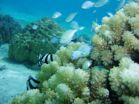(Press-News.org) NARRAGANSETT, R.I. – August 29, 2012 -- Estimates of the total mass of all life on Earth should be reduced by about one third, based on the results of a study by a team of scientists at the University of Rhode Island's Graduate School of Oceanography and colleagues in Germany.
The research was published this week in the Proceedings of the National Academy of Science.
According to previous estimates, about one thousand billion tons of carbon is stored in living organisms, of which 30 percent is in single-cell microbes in the ocean floor and 55 percent reside in land plants. The researchers have now revised the number downward. Instead of 300 billion tons of carbon in subseafloor microbes, they estimate these organisms contain only about 4 billion tons. This reduces the total amount of carbon stored in living organisms by about one-third.
"Previous estimates of microbial biomass in the ocean sediments were hindered by a limited number of sample locations preferentially located in near-shore, high-productivity regions," explained Rob Pockalny, URI associate marine research scientist. "With support from the National Science Foundation, we were able to obtain samples from the middle of the Pacific Ocean in some of the lowest productivity regions in the ocean."
Earlier estimates were based on drill cores that were taken close to shore or in very nutrient-rich areas.
"About half of the world's ocean is extremely nutrient-poor. For the last 10 years it was already suspected that subseafloor biomass was overestimated," explained Jens Kallmeyer at the University of Potsdam, Germany. "Unfortunately there were no data to prove it."
So the research team, which also included URI oceanographers David Smith and Steven D'Hondt, collected sediment cores from areas that were far away from any coasts and islands. The six-year work showed that there were up to 100,000 times fewer cells in sediments from open-ocean areas, which are dubbed "deserts of the sea" due to their extreme nutrient depletion, than in coastal sediments.
Pockalny said that the scientists were able to make predictions about microbial distributions in some regions of the world's oceans based on simple parameters like sediment accumulation rate and distance from shore.
With this new data, the scientists recalculated the total biomass in marine sediments and found drastically lower values. The new findings contribute to a better picture of the distribution of living biomass on Earth.
Despite of the high logistical and financial efforts for marine drilling operations, there are more data about the abundance of living biomass in the sea floor than about their abundance on land.
### END
URI oceanographers find there is one-third less life on Earth
New estimate represents fewer subseafloor microbes
2012-08-29
ELSE PRESS RELEASES FROM THIS DATE:
More research needed on the best treatment options for multidrug-resistant TB
2012-08-29
The use of newer drugs, a greater number of effective drugs, and a longer treatment regimen may be associated with improved survival of patients with multidrug resistant tuberculosis (MDR-TR), according to a large study by a team of international researchers published in this week's PLOS Medicine.
Global efforts to control tuberculosis are being challenged by the emergence of strains that are resistant to several antibiotics including isoniazid and rifampicin, the two most powerful, first-line (standard) anti-tuberculosis drugs—so-called multidrug resistant tuberculosis ...
Adverse effects of mining industry provoke hard questions for medical humanitarian organizations
2012-08-29
Increasingly humanitarian organizations will find themselves responding to health emergencies provoked by the adverse effects of mining and other extractive industries, setting up a potential clash to do with the core principles and values at the heart of humanitarian medicine, writes Philippe Calain from the humanitarian medical organization, Médecins Sans Frontières (MSF), in this week's PLOS Medicine.
"A pragmatic approach of engagement with the corporate sector for the delivery of aid, or an implicit support to mainstream development agendas could compromise the ...
Better air quality indicators are needed for the world's cities
2012-08-29
In their August editorial, the PLOS Medicine Editors reflect on a recent Policy Forum article by Jason Corburn and Alison Cohen*, which describes the need for urban health equity indicators to guide public health policy in cities and urban areas. The Editors focus on the need for better air quality data for the world's cities because many cities with the worst airborne particulate levels are in low- and middle-income countries and often have limited data. Worryingly, the World Health Organization estimates that 1.34 million premature deaths were at attributable to outdoor ...
New PLOS collection: Child mortality estimation methods
2012-08-29
Child mortality is a key indicator not only of child health and nutrition but also of the implementation of child survival interventions and, more broadly, of social and economic development. Millennium Development Goal 4 calls for a two thirds reduction in the under-five mortality rate between 1990 and 2015. With the renewed focus on child survival, tracking of progress in the reduction of child mortality is increasingly important. A sponsored collection of new articles on the methodology for estimation of child mortality was published today in the open-access journal ...
Less is more for reef-building corals
2012-08-29
Researchers at the University of Hawaii – Manoa (UHM) School of Ocean and Earth Science and Technology (SOEST) made a discovery that challenges a major theory in the field of coral reef ecology. The general assumption has been that the more flexible corals are, regarding which species of single celled algae (Symbiodinium) they host in coral tissues, the greater ability corals will have to survive environmental stress. In their paper published August 29, 2012, however, scientists at the Hawaii Institute of Marine Biology (HIMB) at SOEST and colleagues documented that the ...
Small family size increases the wealth of descendants but reduces evolutionary success
2012-08-29
Scientists have taken a step closer to solving one of life's mysteries – why family size generally falls as societies become richer.
Evolutionary biologists have long puzzled over this because natural selection is expected to have selected for organisms that try to maximise their reproduction. But in industrialised societies around the world, increasing wealth coincides with people deliberately limiting their family size – the so-called 'demographic transition'.
In a study published in Proceedings of the Royal Society B: Biological Sciences, researchers from the London ...
Kepler discovers planetary system orbiting 2 suns
2012-08-29
Astronomers at the International Astronomical Union meeting announced the discovery of the first transiting circumbinary multi-planet system: two planets orbiting around a pair of stars. The discovery shows that planetary systems can form and survive even in the chaotic environment around a binary star. And such planets can exist in the habitable zone of their stars. "Each planet transits over the primary star, giving unambiguous evidence that the planets are real," said Jerome Orosz, Associate Professor of Astronomy at San Diego State University and lead author of the ...
NASA, Texas astronomers find first multi-planet system around a binary star
2012-08-29
Fort Davis, Texas — NASA's Kepler mission has found the first multi-planet solar system orbiting a binary star, characterized in large part by University of Texas at Austin astronomers using two telescopes at the university's McDonald Observatory in West Texas. The finding, which proves that whole planetary systems can form in a disk around a binary star, is published in the August 28 issue of the journal Science.
"It's Tatooine, right?" said McDonald Observatory astronomer Michael Endl. "But this was not shown in Star Wars," he said, referring to the periodic changes ...
Why are there so many species of beetles and so few crocodiles?
2012-08-29
There are more than 400,000 species of beetles and only two species of the tuatara, a reptile cousin of snakes and lizards that lives in New Zealand. Crocodiles and alligators, while nearly 250 million years old, have diversified into only 23 species. Why evolution has produced "winners" — including mammals and many species of birds and fish — and "losers" is a major question in evolutionary biology.
Scientists have often posited that because some animal and plant lineages are much older than others, they have had more time to produce new species (the dearth of crocodiles ...
Space-warping white dwarfs produce gravitational waves
2012-08-29
Gravitational waves, much like the recently discovered Higgs boson, are notoriously difficult to observe. Scientists first detected these ripples in the fabric of space-time indirectly, using radio signals from a pulsar-neutron star binary system. The find, which required exquisitely accurate timing of the radio signals, garnered its discoverers a Nobel Prize. Now a team of astronomers has detected the same effect at optical wavelengths, in light from a pair of eclipsing white dwarf stars.
"This result marks one of the cleanest and strongest detections of the effect of ...
LAST 30 PRESS RELEASES:
Beech trees use seasonal soil moisture to optimize water uptake
How thinning benefits growth for all trees
Researchers upgrades 3-PG forest model for improved accuracy
Achieving anti-thermal-quenching in Tb3+-doped glass scintillators via dual-channel thermally enhanced energy transfer
Liquid metal modified hexagonal boron nitride flakes for efficient electromagnetic wave absorption and thermal management
Failure mechanisms in PEM water electrolyzers
Study captures how cancer cells hide from brain immune cells, shows that removing their “don’t eat me” signals stops their escape
New breakthrough in detecting ‘ghost particles’ from the Sun
Half of people arrested in London may have undiagnosed ADHD, study finds
From dots to lines: new database catalogs human gene types using ’ACTG’ rules
Persistent antibiotic resistance of cholera-causing bacteria in Africa revealed from a multinational workshop for strengthening disease surveillance
SwRI, Trinity University to synthesize novel compound to mitigate effects of stroke, heart attack
Novel endocrine therapy giredestrant improves disease-free survival over standard of care for patients with early-stage breast cancer in phase III lidERA trial
Gen Z views world as "scary place" with growing cynicism about ability to create change
Biosensor performance doubled – New applications possible
Leveraging incomplete remote sensing for forest inventory
Key chemical in dark chocolate may slow down ageing
New 15-minute hepatitis C test paves the way for same-day treatment
Uranus and Neptune might be rock giants
Magnetically actuated soft electrodes for multisite bioelectrical monitoring of ex vivo tissues
FAU engineers decode dementia type using AI and EEG brainwave analysis
Carrier-free peptide–daunorubicin–small interfering RNA nanoassembly for targeted therapy of acute myeloid leukemia
Global Virus Network announces appointment of new board members
Artificial beaver dams show promise in offsetting climate change effects
Could hidden infections be fueling long COVID?
Targeted oxygen for initial resuscitation of preterm infants
Researchers develop models to help diagnose ALS earlier through blood biomarkers
Jeonbuk National University researchers develop novel eco-friendly and photo-switchable smart adhesives
Magnetic ordering induces Jahn–Teller effect in spinel-type compounds
A mitochondrial protein may hold the secret to longevity, new study finds
[Press-News.org] URI oceanographers find there is one-third less life on EarthNew estimate represents fewer subseafloor microbes




